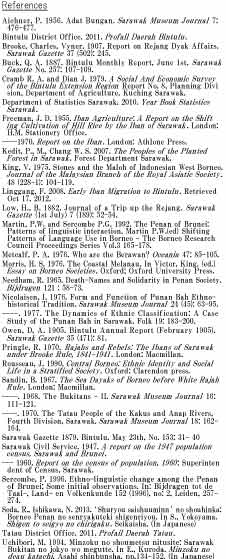Ethnoscape of Riverine Society in Bintulu Division [Yumi Kato, et al.]
Hiromitsu Samejima (Center for Southeast Asian Studies, Kyoto University)
Ryoji Soda(Graduate School of Literature and Human Sciences, Osaka City University)
Motomitsu Uchibori (Faculty of Liberal Arts, The Open University of Japan)
Katsumi Okuno(College of Liberal Arts, J.F.Oberlin University)
Noboru Ishikawa (Center for Southeast Asian Studies, Kyoto University)
Introduction The study site of this project is the riverine areas of the Kemena and Tatau Rivers in the Bintulu Division. This article provides an overview of the ethnic groups living along those rivers. However, the details of these people, their backgrounds, and their inter-ethnic relationships are covered in many other studies, so this article solely focuses on depicting the overviews of the ethnoscape. The authors hope this article will be used by social science researchers as a depository; adding knowledge and information to it along with their further studies. For natural science researchers it could provide an ethnic directory that researchers can bring along to the field work for reference.
Overview
The statistical data shows that the population of the Bintulu Division was approximately 230,000 in 2010. The Iban, which occupies 40% of the population, is the primal ethnic group followed by the Chinese (14%), Melanau (10%), Malay (9%) and Bidayuh (1%) (Fig. 1). Orang Ulu, comprising inland ethnic groups such as the Kayan and Kenyah covers a mere 5% of the population. The ratio of non-Malaysia citizens reaches as high as 21% of the total population in this area. A significant feature of the Bintulu Division compared to the constituent population ratio of the whole of Sarawak is that the division has more non-Malaysian citizens, Iban and Melanau people than other areas and less Chinese and Malay residents.
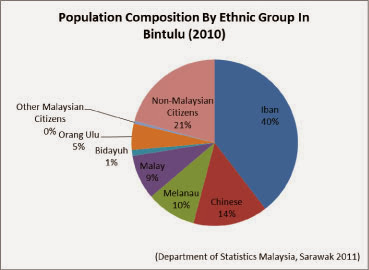
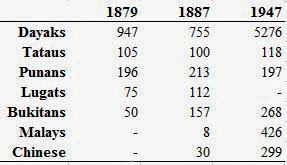
Tab. 1: Demographic Change at Bintulu (Dayaks=Ibans, Punans=Penan and Punan)
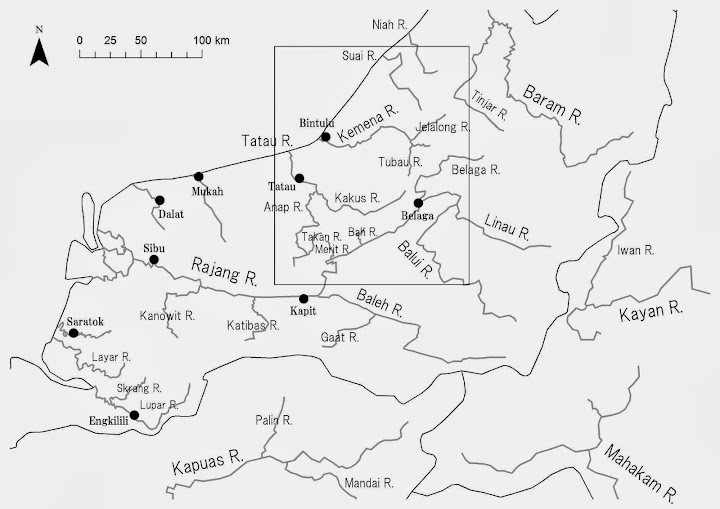
Fig. 2: Major Rivers in Northern Borneo
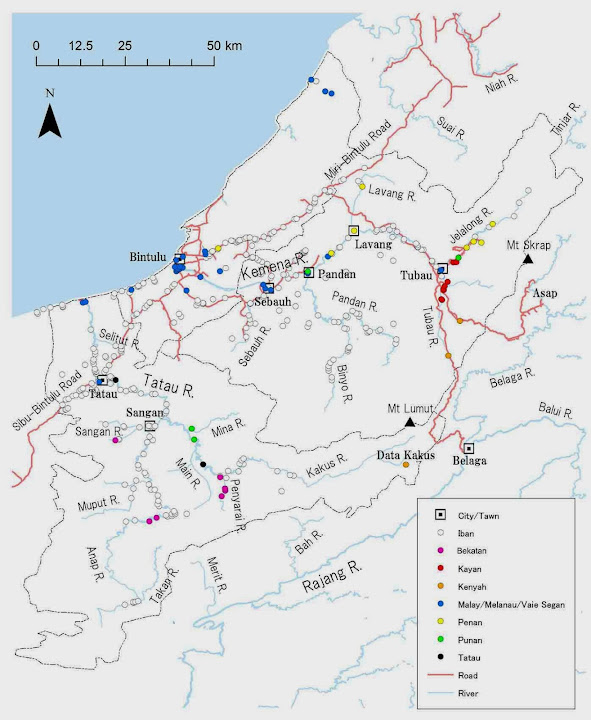
Fig 3: Distribution of villages along the Kemena and Tatau Rivers
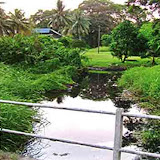
Iban
The Iban are the largest ethnic group in Sarawak. They are also found in Sabah, Brunei and Indonesia. The Iban, previously inhabiting coastal areas, were called Sea Dayak, as many of them were engaged in acts of piracy. The Iban are said to come from the Kapuas River of West Kalimantan, Indonesia (Pringle 1970). They mainly lived by swidden agriculture and moved their settlements through the process of shifting cultivation. They came to the southwest area of Sarawak by the 15th century and settled on the Lupar, Skrang, Saribas/Layar, and Rajang Rivers, and then gradually spread into all areas of Sarawak in the one hundred years that followed (Fig. 2). By virtue of the custom of bejalai, Iban males had no hesitation in exploring unknown places for the trading of jungle produce. Through the 19th to early 20th centuries, they practiced headhunting vigorously in accordance with their traditions. The Iban’s headhunting was practiced in the course of their battles with other minor ethnic groups such as the Punan or Bekatan, and those groups were gradually edged to the Kemena and Tatau Basins. Other groups like the Penan, Tatau and Lugat are said to have fled from the Iban or decided to become a part of Iban societies (Kedit and Chang 2007). Bekatan people, on the other hand, became local guides to lead Ibans on their headhunting expeditions, developing cooperative relations (Uchibori, 1994). The Iban have made a living by planting rice, tapping rubber, catching fish, hunting animals such as wild boars and raising livestock. The cultivation of rice isn’t as popular today as it was before, and many of them find jobs in the urban areas or timber companies. Oil palm smallholdings are also popular among them today. Among Iban communities, traditional religion is still strong but it is common to find many Christians. Their traditional harvest festival, gawai, is today held on the first day of June, which is officially designated as a public holiday by the state government of Sarawak. During the festival period, home-brew wine, tuak, made from sweet rice is served. Iban society is said to be non-hierarchical and bilateral (Freeman 1955), and their language is similar to Sarawakian-Malay. According to government records, there are 410 Iban longhouses in all areas of the Bintulu Division. 229 of them are in the Bintulu District and the remaining 181 longhouses are in the Tatau District. Those longhouses are dispersed throughout much of the riverine system except in the upper regions of the Tubau and Kakus Rivers (Bintulu District Office 2011; Tatau District Office 2011). The Iban moved into the Kemena and Tatau Basins during the mid-19th to the late 20th century. They came from various places of western Sarawak and experienced frequent gathering and break-ups in the process of settling in the Division. They were from Seratok, Sarikei, Skrang, Sibu, Engkilili, and Saribas (Layar) (Fig. 2). The migration of Iban in the middle area of Kemena River began when Penghulu Jelani of Skrang moved into the tributary of Sebauh River, with permission of the Brooke government and soon many groups of Iban followed (Linggang 2008). Around the Jelalong River, the upper part of the Kemena River, until the early 20th century both the Brooke government and British colonial government did not authorize the Iban to immigrate into this area. This changed with the formation of the Federation of Malaysia in 1963. Today, Iban people inhabit the entire area of the Jelalong River. The earliest stage of Iban settlement in the Tatau area is estimated to be the mid-19th century during the Brooke period. Iban people of Rh. Agul, along the Muput River and Rh. Sagin, along the Tatau-Bintulu Road are said to have moved into the junction of the Muput and Tatau River in the middle of the 19th century at the time of the rebellion of Rentap. Along the Kakus River, the upper reach of the Tatau River, the Iban were not allowed to settle there until the 1960s, but now Iban communities can be found from the lower part of the Tatau to upriver of Anap (Photo 2). Aside from those cases of settling by communities, several families settled there and have been living with the Penan, which is often the case with the communities along the upper region of the Jelalong River.
The Chinese occupy the second largest ethnic group in the Bintulu Division. Government statistics show that there are 32,000 Chinese residents in the Bintulu District, and 2,000 live in the Tatau District. The Chinese are comprised of various dialect groups like Hakka, Fuzhou and Teochu, based on where each of them comes from. Officially Chinese settlements in the Bintulu District began in the middle of the 19th century (Liggang 2008). It is known that the Chinese have been living in the Tatau Town since the Brunei era. Back then, they were active traders, dealing with many kinds of forest products and conducted business with local people of the upriver regions. Today, many of them are doing well in their businesses running companies or shops in urban areas. The dialect groups of Chinese, dominating the timber and plantation businesses in Bintulu, are the Fuzhou who mainly moved from Sibu. The Fuzhou came to the Kemena Basin in the 1920s with the support of the Brooke government in order to cultivate rice and rubber in Sebauh. They were keen business people and soon started the trade of sawn iron wood and its roofing (atap belian). Today, the Chinese population has spread into even small bazaars like Sangan or Tubau, where they are conducting businesses with local people. In upriver rural areas, there are many cases of inter-marriage and adoption of children between the Chinese and indigenous people (Photo 3). The trade of forest products such as dammar, jelutong and rattan in those bazaars was mainly managed by the Teochu. Because of this situation, it is common to find people who have parents from the Chinese and other ethnic groups.
Kayan is an ethnic group living mainly around Tubau Basin, and the lower Jelalong Basin. The Kayan people also live in the Baram Basin, the upper region of Balui, North and East Kalimantan of Indonesia. They engaged in bloody conflicts with the Iban in many different areas until the 1920s. Just like the Iban, they practice swidden cultivation of rice as their main crop as well as fishery, hunting, rubber tapping and pepper cultivation. The Kayan people in the Tubau area used to trade forest products with the Penan of the Belaga region2. Nowadays many of them work in urban areas or with timber companies and not many young Kayans live in longhouses anymore. The Kayan people had their own aboriginal religion called adat Dipuy but later in the mid-20th century the belief of adat Bungan3 became popular among them. Today, most Kayans believe in Christianity. Unlike the Iban, Kayan is said to be stratified society. Their society is comprised of ruling class (maren) the position of which is hereditary, lower aristocrats (hipuy ok), commoners (panyin) and slaves (dipen) (Rousseau 1990). The slave class has already been officially abolished. In general, those who belong to the ruling class tend to have higher education thus running good businesses or huge oil palm plantations nowadays (photo 4). In the Bintulu Division, Kayan villages (longhouses) are found only in the area of Tubau but not in the Tatau Basin. There are two Kayan villages in the lower reaches of the Jelalong River and eight villages in the middle area of the Tubau River. The total population of those eight Kayan villages is about 1,500 (Fig. 3). The motherland of the Kayan people is the upper Kayan River in North Kalimantan, Indonesia, and it is said to extend across the ridge to Balui Basin by the 1780s (Cramb 1979). At the beginning of the 19th century, they were believed to have moved to the Tubau River area, away from conflicts with other groups, seeking better farmland (Cramb 1979, Rousseau 1990). The Kayan people lived together as one community called Uma Juman when they were along the Balui River. When they moved to Tubau, the community split into five villages: Uma Juman, Uma Awai, Uma Paku, Uma San and Uma Tevo4. At the time the Kayan began to move to Tubau, many Penan people lived at the Kemena Basin but later they were said to have been driven to Labang, Tinjar and Baram5. The Kayan people at Tubau are said to have formed rebel forces against the Brunei army to protest the tax collection against them by the sultan of Brunei.
The Kenyah is an ethnic group of people living in the upper regions of the Tubau River, a tributary of the Kemena. Many Kenyah villages are also found in the upriver Kakus, a side stream of the Tatau River (Fig. 3). The Kenyah have much in common with the Kayan in the aspects of culture and way of living. However the language is different and there are more than 40 subgroups like Lepo Tau or Badeng. It is believed that they originally came from the area of the Iwan River of North Kalimantan and moved to Sarawak several centuries ago (Fig. 2). Just like the Iban and Kayan, Kenyah people have made their living by swidden agriculture, fishing, hunting animals and raising commercial crops. The groups of Kenyah people can be found, like Kayan, in the areas of Baram, the upper part of Balui, and North Kalimantan of Indonesia and their society has a hierarchical system with headmen and aristocrats (Rousseau 1990). In the Kemena River basin, there are four villages in the upper part of the Tubau River and six along the Kakus River in the Tatau District (photo 5). There are altogether ten Kenyah villages in the Bintulu Division with a population of 2,500 who came from the upper Rajang. The arrival of Kenyah at the Tubau Basin is estimated as the 1960s. They are said to have come to the Tubau area from Long Bangan of the Belaga River. Those Kenyah villages at both the Belaga and Tubau Rivers were once on the route which connected Tubau and Belaga across the ridge line. Later in 1985 Kenyah people began to settle in the area of the Kakus River. They were the people originally from Indonesia, who moved into Long Busang of the upper part of the Balui River in the 1960s and moved to Long Dungan in the lower part of the Belaga Town in 1976. Some of them moved to Data Kakus, the upper region of the Kakus River and formed a new community. It is said that the government offered 1,284ha of land to the Kenyah and provided them with identification cards6. The community gradually broke into four or five longhouses and today there are six longhouses with 30 to 40 households in each of them. Punan The Punan is an ethnic group that is often confused with the Penan people, but the two ethnic groups have totally different languages and cultures. While the Penan led nomadic life, the people of Punan are said to have practiced swidden agriculture since 300-400 years ago (Nicolaison 1976). People believe that the Punan originally came from the Mandai River of West Kalimantan (Nicolaison 1976). They have been mainly dependent on swidden agriculture, raising cassava, taro and sugarcane, catching freshwater fish and hunting animals. The society of Punan is class-based and is composed of ruling class (lajar), commoners (panyin) and slaves (lipien) (Nicolaisen 1976). However, the slave class is obsolete today. Punan people worshiped besavik, their traditional religion for a long time but they adopted adat Bungan later and today many of them are Christians. The traditional burial method of the Punan is unique; the remains of the ruling estate is put on a carved wooden pole called kelirieng. In the Bintulu Division approximately 1,400 Punan people live in four Punan villages. At the Kemena Basin one village is in Pandan and there is another village along the Jelalong, upper Kemena. There are two more villages in the Tatau riverine in the middle part of the Kakus River (Photo 6). Punan communities on the Kakus River are said to be the groups of people who came from the Bah River, a tributary of the Rajang River (Nicolaisen 1976). This period coincided with the time when the Kayan people moved to the Balui Basin from Usun Apau and the Kayan often targeted the Punan for their headhunting rituals. Those political unrest and ethnic conflicts triggered the Punan to move to the Kakus area (Sandin 1970, Nicolaisen 1976). Back then, the Tatau River area was ruled by Tatau people but soon Punan people began to settle in this area when their leader married Tatau woman (Sandin 1970). In fact one of the longhouses along the Kakus originally belonged to the Tatau people (Sandin 1970). This explains why Punan people have political advantage in the Kakus area even today (Sandin 1970). Punan people living in the Pandan area today also came from the Bah River to Labang around the same period. Back then, the Kemena Basin was dominated by Penan and Vaie Segan (Segan)7. Inter-marriage between Punan and Segan women increased when the Punan began to live in Labang and that encouraged Punan people to move to Pandan. Nicolaisen (1976) alleged that Punan of the Jelalong Basin were from the Bah River and fled from the headhunting by the Iban during the Brooke era. Cramb (1979), in reaction to Nicolaisen’s viewpoint, alleged that those Punan communities along the Jelalong gradually migrated into the area, looking for forest products. There had been communities of the Kayan and Penan in the Jelalong riverine area when the Punan moved to this area, but the Iban had not arrived yet. It is said that the Punan asked the Kayan people for their permission to settle in the Jelalong Basin (Cramb 1979). The intercommunication is still active between the Punan communities of different riverine systems, and there are many affinal ties among them. Bekatan
They are sometimes called the Bukitan by the Iban people but they call themselves Bekatan, Beketan or Begatan. Bekatan people live in three villages in the middle part of the Anap River, the upper Tatau and five villages along the Penyarai River. The total population of those eight villages is about 1,200 (Fig. 3). Bekatan people were originally hunter-gatherers, living on sago for a long time but they began swidden cultivation in the late 19th century earlier than the Penan people (King 1975). Bekatan society is hierarchal and has a noble class (marin), middle class (panyen), lower class (setengah linou) and slaves (areh)8 (Kedit and Chang 2007). The majority of Bekatan believe in Christianity today but there are some groups of Bekatan who celebrate the festival of gawai just like the Iban. Bekatan people, originally living in the Mandai River, West Kalimantan, entered Sarawak via the Palin River in the upstream of the Kapuas, and settled along the Batang Ai River for many years (Sandin 1967). When the Iban came to this area seeking settlements by practicing headhunting, some Bekatan decided to merge with the Iban while others fought with them and became the Iban’s slaves. There were also some groups of Bekatan that fled from the Iban to as far as the Katibas, Kanowit, Gaat, and Balleh Basins (Sandin 1968). The Bekatan of Sarawak can be categorized into four groups based on the route they took to enter Sarawak from West Kalimantan. They are the Bekatan Malong, Bekatan Sut, Bekatan Kanyau and Bekatan Ngemah9. The Bekatan communities along the Anap River are said to be the Bekatan Malong and Bekatan Sut, while the community along the Kakus River is said to be the descendants of the Bekatan Malong (Sandin 1968). Those Bekatan people of the eight villages along the Tatau River arrived in this area via different routes. The Bekatan, living in Sangan today, are said to come from Saribas, Oya, Mukah, and Balingian areas having entered Sangan from the lower part of the Tatau River (Cramb 1979). The Bekatan of the Anap River are said to have settled in this area in the middle of the 19th century, moving from the Rajang River via the Merit River and across the ridge10. Before the arrival of the Iban in the Tatau Basin, these areas were dominated by the Tatau and the Bekatan. When the Iban arrived some groups of Bekatan people chose to give in while others who couldn’t live together with the Iban are said to have moved to areas further upriver of the Sangan or the Penyarai (Sandin 1967, 1968). The Penyarai Basin was the home of the Tatau people before the Bekatan arrived. Later the Tatau people left the Penyarai Basin in fear of a supernatural phenomenon (curse) and moved downriver of the Tatau; then the Bekatan people came over from the Anap River and filled the gap left by the Tatau people with the permission of the Punan11. The Bekatan people who remained in the area of the Takan River in the upper Anap River gradually settled in the middle part of the Anap River when the Brooke government encouraged them to move down the river (Photo 7). The Bekatan used to make their living by collecting illipe nuts and rattan to sell them in the Tatau bazaar. Even today Bekatan villages tend to have a solid number of community members and many villagers engage in rice farming.
The Penan is one of the ethnic groups that settled in the Kemena riverine earlier than the other groups. Today the areas they inhabit have spread to the middle part of the Kemena River, upriver of the Labang, the Jelalong River and along the roadside of Miri-Bintulu road. Penan communities are also found in the upper parts of the Baram and Rajang, as well as North and East Kalimantan, West Kalimantan and Brunei (Martin 1992; Sercombe 1996). They were hunter-gatherers, engaging in a nomadic life-style, and made a living mainly through wild animals in the forests. Previous studies indicate that the Penan in the areas of the Kemena and Jelalong Rivers began to settle in those areas between 1830s and 1880s and started agricultural activities (Needham 1965, Cramb 1979). They had their original religion back then but today many of them believe in Christianity and there are some who have converted to Islam. The Penan and Iban live together in several villages, and some communities practice the Iban traditional festival of gawai (Photo 8). The Penan of the coastal areas settled relatively early and many of them gradually turned to Islam, which indicates they were subject to the influence of other ethnic groups (Cramb 1979). Except those of the Jelalong River, many Penan people in the Bintulu Division are Muslim and are called Penan-Muslims. There are two Penan-Muslim villages along the Miri-Bintulu Road with a total population of 500 (Photo 9). The Penan-Muslims are also found in Kampung Labang, Sebauh, at the river mouth of the Labang, Kampung Sebubun in Labang, and Kampung Maskat at the middle reach of the Kemena River. In those Penan-Muslim villages many people married Malay and Vaie Segan and they often speak the language of Vaie Segan. There are four Penan villages along the Jelalong today with a total population of 400. Those people are said to be the descendants of the Penan who moved from Usun Apau (Needham 1965). Some parts of the group are said to have once lived in the caves of Bukit Sekrap12. Just like other ethnic groups, inter-marriages are common in Penan communities, and there are many cases where a person is registered as Penan but speaks Iban. This is especially observed in Penan communities along the Jelalong River where inter-marriage with the Iban is common. Cramb (1979) described that those Penan communities are apparently indistinguishable from the Iban, and predicted that the ethnic consciousness of the Penan would fade away as time passes. However, some of the villagers have not lost their identity as Penan but sometimes (especially in political context) they are eager to be regarded as Penan (Soda and Ishikawa 2013). Penan communities of the upper Labang River have different backgrounds and those people are said to have once lived in the cave near the headwater of Labang River and then began to move down the river over time. Historically those groups have deeper relationships with the Penan of the Suai River.
The Vaie Segan is often written as Vaee, Baee or Segaan. Also there are other names like Melayu Bintulu, Melanau Vaie, Orang Bintulu, Vaie or Segaan. Vaie Segan people live in the lower part of the Kemena River and use their own language which is similar to the Tatau language. People use the language of Vaie Segan as a common language in the city of Bintulu. Among the communities of Vaie Segan, inter-marriages with the Melanau and Malay or other ethnic groups are quite common and many Vaie Segan believe in Islam. They are often called Melayu (Malay) in the Jelalong area. Legend has it that the Vaie Segan lived in the land called Bukit Lumut. They made their living by hunting and gathering and lived mainly on sago as their staple food. Bukit Lumut is located 15 km northwest of Belaga, the dividing ridge of the Kakus and Pandan Rivers (Fig. 2). Gradually they moved down to the Binyo River basin and practiced a nomadic lifestyle. Later they seemed to continue moving down the Kemena to the Segan River area, near the mouth of Kemana River, and finally they settled there. The Sarawak Gazette of 1879 described Segan people as living by catching fish, often threatened by pirates and raided, slaughtered, and captured (Sarawak Gazette 1879: 38). Before Bintulu was ceded to James Brooke from the Brunei Sultan on August 11th of 1861, the coastal area was occupied mainly by the Vaie Segan and the Malay from Brunei. The interaction with Arabian missionaries who came to this area to sell agate encouraged the Vaie Segan to convert to Islam from the 1930s. The Islamization of the Vaie Segan advanced in accordance with the number of inter-marriages with the Arabs and Brunei Malays increased gradually13. Today many Vaie Segan people can be found in Bintulu, Pandan and Sebauh14. There are many Vaie Segan communities such as Kampung Baru, which is located on the upstream of the Bintulu Old Town, Kampung Sebuan Kecil and Kampung Jepak which are located on the opposite bank of Kampung Baru across the Kemena River, and Kampung Melayu Tubau located near Tubau Town (Photo 10). Many Vaie Segans used to live in Kampung Melayu Tubau, but most of them have moved to the urban area of Bintulu. It seems that other ethnic groups come to live in the village currently. There is practically no Vaie Segan resident, although an official record shows that there are seven Vaie Segan households in the village. The Vaie Segan also live in some villages downstream of Kemena. Kampung Pandan, Sebauh is one of those communities which is located a little upstream from the Pandan Town, on the left bank of the Kemena River. The village has 74 households and the largest group among them is Malay and there are also a couple of Vaie Segan families. There are two more villages, Kampung Hulu (28 households) and Kampung Hilir (54 households) near the Sebauh Town and both of them are multiethnic composites of Malay and Vaie Segan. People sometime call those two villages the single community of Kampung Sebauh. In the Jelalong Basin about seven households of Vaie Segan have married into Rh. Resa, a longhouse of the Penan and the members of this community use the language of Vaie Segan as their common language. In the Brooke period there was a time when Kayan and Lavang (Segan) held peace making ceremony as inter-ethnic battle had almost become out of control. When the Kayan conquered too much territory by their excessive headhunting, Oyong Tija, a female leader of the Lavang (Segan) community, solicited a government administrator named Abang Tali to help in brokering a deal with the Kayan leader, Mering Bato. After this negotiation both ethnic groups were imposed with an arrangement by which the Kayan were not allowed to live lower than the confluence of the Tubau and Jelalong Rivers, and the Segan should not live in the upper part of the junction of the Labang and Kemena Rivers15.
This ethnic group is the oldest group of settlers in the area of the Tatau River. Its total population is not clear. Originally there were six communities of the Tatau but the current population is much smaller than before. Today they are absorbed into the communities of the Iban and Punan, and almost all of them have conjugal relations with other ethnic members. They speak the Tatau language which is similar to Melanau (Nicolaisen 1977). Most of them have Christian beliefs and they still keep their old religion, which is similar to traditional Iban religion as well. Originally, the Tatau had a hunter-gatherer life style but they were considered to have started swidden agriculture earlier than the Penan (Sandin 1970). Today the Tatau people live in longhouses located a little upward of the Tatau Town (Photo 11) and in Rh. Sylverster located in the middle part of the Tatau River. However, most of the inhabitants of these villages are the Iban. The descendants of Tatau people can also be found in the Punan’s longhouses of the Mina River, Anap River and the Bekatan’s longhouse of the Penyarai River as well. They used to have their own longhouse in the Penyarai Basin, the upper part of the Kakus River and the Takan River, the upper part of the Anap River with a much larger population than today. They began to move down along the river much earlier than other groups like the Punan and Bekatan. They allegedly remained deep in the forest when the Iban and Bekatan were actively engaged in headhunting. The legend of Tatau says that several generations ago, one day a Tatau man killed a huge serpent with his blow dart when he saw the serpent standing and eating figs (kayu kara) near the Penyarai River. He brought it back to the village and shared the meat with other villagers. The Tatau people ate the serpent and soon after that, almost all the villagers died because of the curse of the giant snake. The Tatau people have another stroke of misfortune much earlier than that when they lived downstream of the Tatau River. They caught a caterpillar as big as a wild boar and they cooked and ate it. After this incident the newborn babies began to die one after another and the curse induced a sharp decline in their population. Aside from those legends, there was an outbreak of smallpox in the areas of the Main and Selitut Rivers that took many Tatau lives back then. This predicament forced the survivors to commit incest in order to resurrect the Tatau community. Today inter-marriages with the Punan, Bekatan and Iban are quite common. Burial poles of the Tatau called kelirieng are scattered along the Tatau River. According to the Tatau people along the lower Tatau River, there were six keliriengs and two salongs (different type of burial pole) that were constructed in the late 19th century but all of them were fell down when a heavy flood hit this area. There were many traditional burial poles of the Tatau along the middle part of the Tatau River, the upper Anap and the Penyarai, but today most of them are under water16.
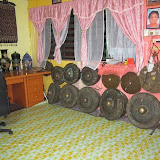 Lugat
LugatThe Lugat is the smallest ethnic group in this region. The Lugat people speak their own language which is similar to Sihan but today only a few families still use their language. They don’t own their longhouse, and live together with the Chinese, Tatau, Bekatan or other ethnic groups. The Lugat have always been a small ethnic group in this area. There are several Lugat families in the Tatau Old Town, and all of them are mixed with the Chinese. They take charge of edible bird’s nest farming; its cleaning, processing and the construction of bird farm houses. Some Lugat descendents who married a Tatau (Punan) can be found in the Punan’s longhouse in the middle part of the Kakus River. There are also some Lugat descendants in the Bekatan longhouse along the Sangan River. Historical sources indicate that the Lugat were a group of people who were hunter-gatherers in the area of the Gaat River, a branch of the Balleh River (Low 1882, Brooke 1907, Freeman 1970). By the late 19th century they had started to live in the middle part of the Rajang together with the Sihan, Bekatan and other ethnic groups (Low 1882). Later they moved to the Tatau Basin but in the early 20th century, they oscillated between the Tatau and Rajang Basins (Owen 1905). The folk legend of Tatau indicates that the Lugat used to live in the cave of Bukit Lumut for a long time. They didn’t have any metal pots or any other utensils so they put food in the ground and made a fire above it to roast the food. It is said that the Lugat decided to leave the cave and lived together with the Tatau when the Tatau people persuaded them to do so17. The oral history of the Lugat suggests that long ago they used to live in Keragan Kawit, the upriver of the Anap, led by a Lugat man called Kawit. Later, one of Kawit’s children married a Bekatan and another child married a Tatau. The people of Lugat who are living in the old town area of Tatau today are said to be the descendants of the latter child of Kawit18. Although the size of their community is small, the language of the Lugat is still predominant among them and children speak Lugat fluently. An ethno-history of the riverine societies
This article has covered so far overviews of each ethnic group living in Kemena and Tatau Basins. Needless to say, the current ethnoscape of those riverine societies has been formed by the human interactions across different river basins. In this section we will overview the history of the people’s interactions in the areas between the Kemana and Tatau Rivers. Since early times, the Vaie Segan or Penan had a nomadic life style along a considerable range of the Kemena River. The ancestors of the Penan living in Rh. Jelaihi of the Jelalong River today seemed to recognize the great open space between the river-mouth area of the Jelalong and Kemena Rivers as their living space and used to make many campsites there. Later the Kayan people moved from the Balui River and entered the Tubau area while the Chinese groups began to move into inland areas of the Kemena Basin. In addition, the Punan came in from Pandan or the middle area of the Rajang. And then the Iban came to the Kemena from various areas of west Sarawak, followed by the Kenyah from the Belaga Basin. The history of human interactions and migration of people shows that various groups came to the Kemena River area from such as the Rajang, Balui, Belaga, and various places of west Sarawak, and as a consequence, formed Kemena riverine society there. The same situation was observed in the Tatau River area where the Tatau people had been living for a long time. The Punan people first entered this area at the beginning of the 19th century, then the Bekatan followed by the Chinese and the Lugat in the late 19th century, and then the Iban came along. The latest case was in the 1980s when some groups of Kenyah came into this area from the Balui as a result of the land shortage due to the population increase in their community. The ethnoscape of this area has, historically speaking, always been generated by those who moved in from nearby rivers such as the Rajang and Balui. Various events that occurred in nearby river basins triggered groups of people to move into the areas of Kemena and Tatau Rivers. In the 1820s, when the Kayan began to move into the Balui Basin, some of the Punan decided to move from the Rajang to the Tatau in an attempt to evade political insecurity and conflicts between the Kayans. In the case of the Kayan, they moved from the Balui Basin to the Kemena Basin in the 19th century in order to avoid conflicts with other ethnic groups. The same situation was seen with the groups of Bekatan of the Rajang River that came into the Tatau Basin in the 19th century after fleeing from the headhunting of the Iban. When the Iban faced political commotions including Rentap’s rebellion in western Sarawak, they decided to move into the Kemena and Tatau Basins to seek new land. What is remarkable is that those newly arrived groups such as the Iban, Kayan or Bekatan inevitably drove the Penan and Tatau who had long lived in the areas of the Kemana and Tatau to move to the upriver areas. Some groups even went all the way to other river basins. The Penan groups, for instance, went to the Tinjar Basin to avoid conflict with the Kayan. There was also the case of the Iban who settled in the Kemena Basin and moved eastward again later. The backgrounds to the mass migration of each ethnic group were varied and neither were their migration patterns. The Iban, Kayan and Kenyah moved as relatively large groups with several households. Like the Punan, on the other hand, people also trek across the rivers on an individual basis. This individual traffic eventually made their population increased and form villages and then split with the passage of time. Therefore, this area’s ethnoscape of riverine society is the result of historical human interactions and consequences of events that occurred to the people with different backgrounds and ethnicities. As for the relationships among different riverine societies, there were various moving routes support the traffic. For instance the Bekatan and the Iban people actively use the routes between the upper Tatau River in Tatau Basin and the upper Merit River in Rajang Basin. The Iban people who live upriver of the Tatau frequently come and go to the Kapit Town, on the Rajang River. Even today children of the communities in the upper Tatau attend elementary school in the Rajang Basin and go to secondary school in the Kapit Town19. The inter-riverine route between upper Bah River in Rajang Basin and upper Kakus River in Tatau Basin was used mainly by Punan people. In addition, the Kenyah people in lower Belaga town use the route between upper Kakus River and Balui River. The same situation was observed in the communities along the Kemena, which have a close relationship with the communities of the upstream of the Belaga River. There were important inter-riverine routes between the upper Tubau River in Kemena Basin, and Belaga Basin. It is necessary to investigate not only the Kemena and Tatau, but also expand our scope of research to other rivers in order to see the changes in historical links between the different riverine societies. Multi-layered ethnoscape
The riverine area of Kemena and Tatau is an intersection of the histories of various ethnic groups. The accumulation of those histories has created the current ethnoscape of this area. In this article the situations of each ethnic group have been described separately in order to make it simple and comprehensible, but the reality is much more complicated and indistinguishable, because of high mobility and frequent interethnic marriage. Even though an official record says that a longhouse belongs to a certain ethnic group, in most cases, a wide variety of ethnic members live in the same longhouse together, which makes us hesitate to describe a clear demarcation of ethnicity. The multi layered ethnoscape in this area is developed by the various dimensions and phases, including community formation, its categorization, ethnonyms (autonyms and exonyms), and everyday interactions with different groups. Along the Kemena and Tatau Rivers there are people of the Tatau, Lugat and Vaie Segan without official number. A community is made up of the members with various backgrounds such as family roots, personal histories, religions and languages. Naturally, there are many multi-ethnic settlements of the Iban and Penan, Tatau and Iban, Penan and Vaie Segan or Lugat and Bekatan. There are many cases like in an Iban community, where a small non-Iban ethnic group might appear to have integrated and Ibanized well, or Iban people who adopt a down-to-earth approach and prefer to be regarded as members of the Penan community. But the reality is that this cannot be simplified and requires further observation. The landscape of today’s riverine society of the Kemena and Tatau Rivers is the outcome of people’s interactions and their living activities. The changes continue, like the flow of the rivers, even today. Studying the background of an individual mobility and social relations all of which form a certain part of riverine society will provide us with the interesting inspiration to obtain a big picture view of the riverine society.
Notes
1 Official website of the Bintulu Division Laman Rasmi Bahagian Residen Bintulu
2 According to the interview with Wan Imang of Uma Anyie on Aug. 17, 2011.
3 Adat Bungan is a local religious belief that emerged in the 1950s in central Borneo which was born in a manner that blended traditional religion and various elements of Christianity. This new religion was welcomed as it brought a breakthrough to tradition-bound agricultural practice and helped to increase agricultural efficiency. The introduction of adat Bungan created room for rational interpretation of animism and it gave people a means to evade traditional taboos by practicing various rituals (Aichner1956). The religion once attracted many Kayan and Kenyah people but many of them have turned to Christianity.
4 Same source as previously mentioned in Reference 2.
5 According to the interview with Mering Tuva of Uma Lasah Tuba on Aug. 18, 2011.
6 According to the interview with Penghulu Sanok Magai on Aug. 26, 2011 at Tatau Town.
7 Those Punan people once owned Penan and Segan slaves (Cramb 1979).
8 Though they would not be called as slave, but called as ‘brother/sister’ (Kedit and Chang 2007).
9 Once living in Kanowit, Bekatan Ngemah are assimilated into the Iban community from 1945 (Sandin 1968).
10 According to the interview with Gaing Ungat of Rh. Banda on Aug. 25, 2011.
11 According to the interview with Kanyan Abok of Rh. Kanyan on Aug. 27, 2011.
12 According to the interview with Sintan Juti of Rh. Juson on Aug. 19, 2011.
13 According to “The history of Baee Segaan” (2010).
14 Nicolaisen explained that when the Punan began to settle in Pandan, they called Penan people Laveang. Soon they started to use Segaan for the Penan (Laveang) when many of them began to intermingle with the Malay and Melanau and became Muslims (Nicolaisen 1976).
15 Same source as previously mentioned in Reference 5.
16 According to the interview with Delila Sekudau of Rh. Jalong on Aug. 25, 2011.
17 Same source as previously mentioned in Reference 16.
18 According to the interview with Anyai (Meng Teng Yiew) in the Tatau Town on Aug. 26, 2011.
19 According to the interview with Mawang anak Mat of Rh. Mawang on Aug. 23, 2011.
References
